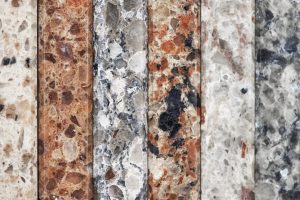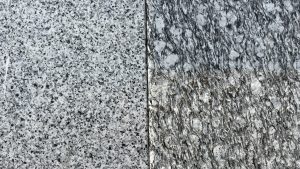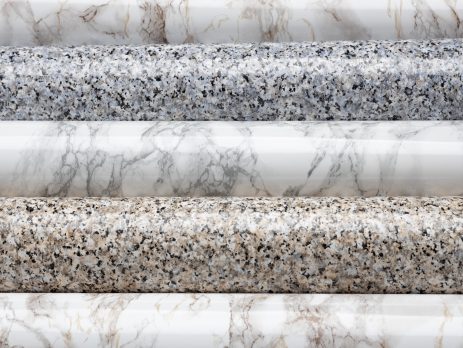Marble or Granite: The differences, similarities, and advantages of each material
Answer the question “marble or granite” and choose the material that best suits the functional and aesthetic needs of your space!
These two materials are beloved for their beauty, durability, and ability to increase the value of a property.
In this guide, we will explore the key differences, common characteristics, and unique benefits of each material in order to answer the dilemma “marble or granite.”
Let’s get started!
What is marble?
Marble is a natural rock formed by the transformation of limestone through intense pressure and heat processes within the Earth. It belongs to the category of metamorphic rocks and consists mainly of calcite (CaCO₃).
This process causes the recrystallization of the rock’s minerals—mainly calcite—creating the smooth, flowing veins for which marble is famous.
Marble has been used since ancient times in sculptures, temples, and palaces and is synonymous with luxury, timelessness, and elegance.
What is granite?

Granite is an igneous rock formed by the cooling and solidification of magma deep beneath the Earth’s surface. It consists of minerals such as quartz, feldspar, and mica, which give granite its grainy and sometimes sparkling appearance.
Due to its strength and durability, granite is a popular choice for high-traffic areas in both homes and commercial facilities.
Marble or granite:
In order to answer the dilemma of “marble or granite”, we will look at some criteria that characterize the two materials that we should take into account!
1. Appearance
In terms of visual appeal, marble and granite offer very different aesthetics. The choice, however, is personal and depends on the needs of each project.
Marble has smooth, flowing veins and a soft, elegant finish. Its appearance is timeless and refined.
Granite has a more granular appearance with “bold” patterns and vibrant colors. Each slab has a unique combination of mineral flecks.
2. Durability and hardness
Granite and marble, due to their porous nature, are vulnerable to stains from liquids. Marble, being generally softer than granite, requires care when in contact with sharp objects that can cause scratches or nicks on its surface. To protect these natural materials, it is important to maintain them regularly with special sealing and strengthening products, which help to increase their durability. Proper care can keep marble or granite in excellent condition for many years.
3. Maintenance requirements
The porous nature of marble and granite makes them vulnerable to acidic substances such as lemon juice. However, there is a solution: with the proper application of sealing and the use of protective products, surfaces can be effectively reinforced.
This way, kitchen countertops, bathrooms, or outdoor areas remain protected from accidental damage.
4. Heat and moisture resistance
Both granite and marble are heat resistant, meaning they can come into direct contact with hot cookware without being damaged.
Despite their heat resistance, it is recommended to use special insulating materials that provide sealing and longer life.
Similarities between marble and granite
Both materials are natural stones and offer unique elegance. No two slabs are exactly alike, which increases their uniqueness and exclusivity.
With proper care, both materials can “live” for decades. They are extremely durable when sealed and maintained properly, making them excellent long-term investments.
The differences stem from their geological origins. These differences also determine how they are used in various applications and constructions.
Advantages of marble
Marble lends a timeless elegance, giving every space a classic and unique look. It is particularly popular with those seeking a timeless and tasteful decorative character.
Finally, marble offers luxury and is an excellent choice for bathrooms, kitchens, and surfaces or walls that stand out aesthetically, creating an impressive focal point in the space.
Advantages of granite

Granite is known for its high durability, making it ideal for areas with heavy daily use, such as kitchen surfaces that are often exposed to stains or scratches.
Finally, it offers great design flexibility, as it is available in a variety of colors and patterns, satisfying different tastes and decorating styles.
Optimal applications of granite and marble
Granite is ideal for kitchen countertops, barbecue areas, entrances, and floors, as well as bar surfaces. Its durability makes it an excellent choice for areas with frequent use or spaces exposed to weather conditions.
Marble applications include flooring, wall cladding, kitchen countertops, bathrooms, fireplace cladding, stairs, decorative columns, as well as furniture and decorative objects. Its versatility and aesthetics make marble a timeless choice for both residential and commercial spaces.
Design tips: You can combine them
It is not necessary to choose exclusively marble or granite. Many contemporary spaces, especially kitchens, choose to combine both materials to take advantage of the strengths of each.
For example, you can use granite on main countertops, where daily use is common and durability is required. For floors and wall coverings, you can use marble to combine aesthetics and functionality.
Property resale value
The choice of natural stone, such as marble and granite, not only enhances the aesthetics of a space but also contributes significantly to increasing its resale value.
These materials are particularly favored by future buyers, making them a high-yield investment. When combined with proper maintenance and care over time, they can significantly increase the overall value of a property.
Frequently asked questions (FAQ)
Which is more durable, marble or granite?
Both materials are quite durable. However, if we had to make a distinction, we could say that granite is slightly more durable. It resists scratches, stains, and heat better than marble, making it ideal for kitchens, outdoor areas, and high-traffic surfaces.
Does marble stain easily?
Marble is porous by nature, but proper waterproofing effectively protects its surface and makes it durable and shiny over time.
Can I cut food directly on these surfaces?
Although both materials are quite durable, it is best to always use a cutting board to avoid scratches or signs of wear.
Which is better for bathrooms: marble or granite?
Both marble and granite are excellent choices for bathrooms, each offering unique advantages. The choice depends on the desired aesthetic effect.
In summary
Having reached the end of the article and analyzed the properties and characteristics of the two materials, you will be able to successfully answer the question “marble or granite”.
Both marble and granite are “safe” and timeless choices for any space. Each of them is distinguished for its durability and aesthetic elegance and promises to upgrade the value of the space. With the right processing, both materials can meet the needs and specificities of each space.
Whether you are remodeling a kitchen, designing a bathroom, or choosing new flooring, this article will help you decide which material is right for your space.
For more information, contact us to find the best possible solution for your project!


